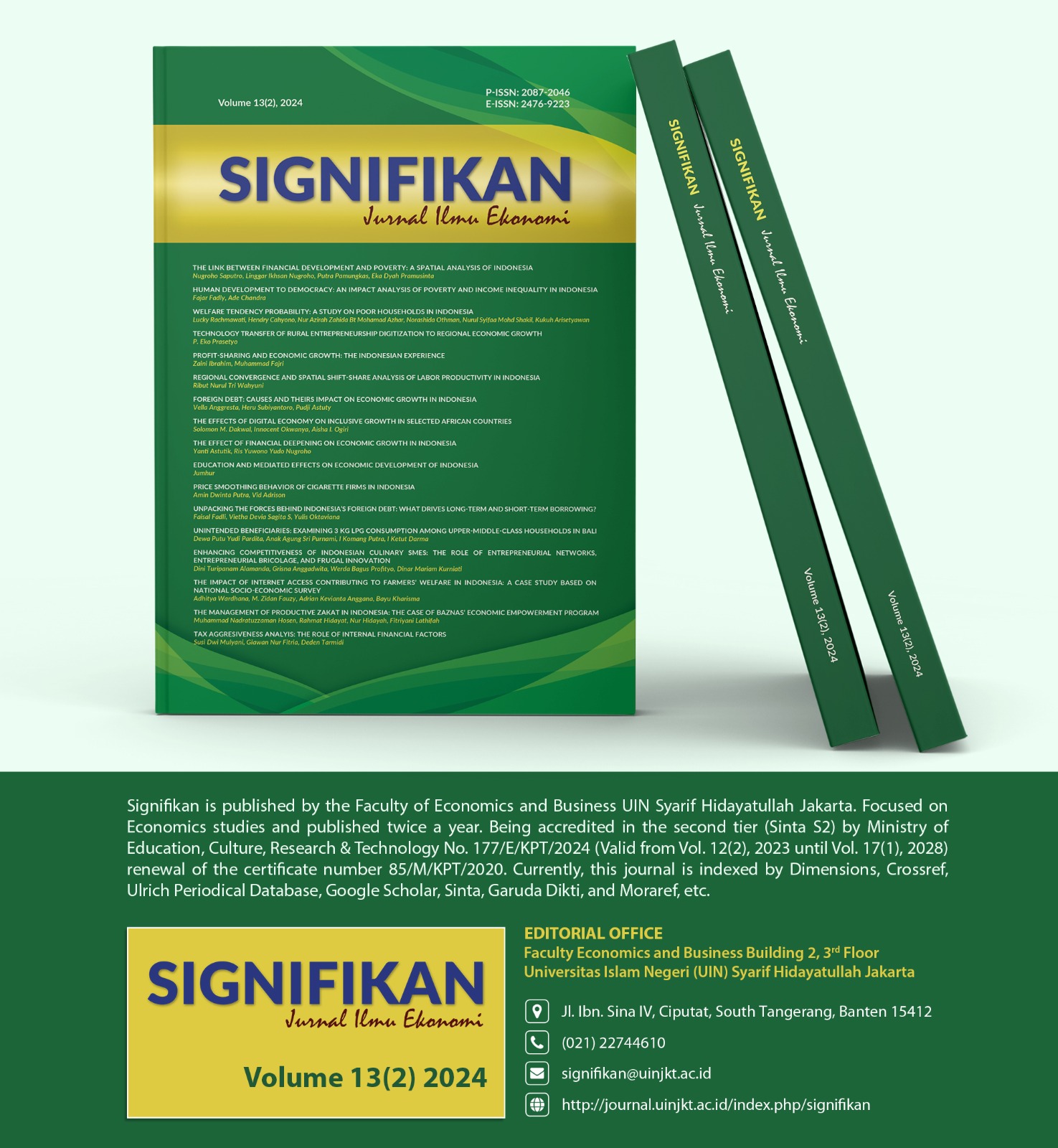Foreign Debt: Causes and Theirs Impact on Economic Growth in Indonesia
DOI:
https://doi.org/10.15408/sjie.v13i2.40681Keywords:
interest rate, exchange rate, import, foreign debt, economic growthAbstract
Research Originality: This study presents a new analysis of the primary determinants of Indonesia's foreign debt and its impact on economic growth over the 1992-2022 period, offering new insights into debt management strategies.
Research Objectives: This study uses 31 years of time series data to analyze the main causes of Indonesia's foreign debt and its effect on economic growth.
Research Methods: This research employs a quantitative approach with data analysis techniques, including classical assumptions, Ordinary Least Squares (OLS), simple linear regression, and hypothesis testing.
Empirical Results: The results indicate that interest rates do not significantly affect Indonesia's foreign debt, while exchange rates and imports have substantial impacts. Additionally, a significant relationship between foreign debt and economic growth is confirmed.
Implications: This study suggests that the Indonesian Government should adopt a multifaceted approach to managing foreign debt, including policies aimed at maintaining low interest rates, strengthening the rupiah, boosting exports, and enhancing government spending efficiency without excessive reliance on external borrowing.
JEL Classification: F34, F43, H63, O11
References
Al Kharusi, S., & Ada, M. S. (2018). External Debt and Economic Growth: The Case of Emerging Economy. Journal of Economic Integration, 33(1), 1141–1157. https://doi.org/10.11130/jei.2018.33.1.1141.
Bekele, F., & Woldeyes. (2021). Debt Sustainability and Management in Ethiopia Lessons from China. United Nations Conference on Trade and Development, 1–28.
Born, B., Müller, G. J., Schularick, M., & Sedláček, P. (2021). The Macroeconomic Impact of COVID-19 on Africa. Policy Studies, 2020.
Bouabidi, M. (2023). The Surge in Tunisia Foreign Debt: Causes and Possible Ways Out. SN Business & Economics, 3(3), 1–23. https://doi.org/10.1007/s43546-023-00443-2.
Dai, M. (2022). The Impact of COVID-19 on the US Economy and the Policy Response. In. Li, X., Yuan, C., & Ganchev, I. (Eds). Proceedings of the 2022 Internasional Conference on Business and Policy Studies. CONF-BPS 2022. Singapore: Springer.
Darwis, F., Wiryono, S. K., & Prasetyo, A. D. (2022). Case of Indonesia: Government Bond Issuer Investor Relations Strategy. JPPI (Ju.rnal Penelitian Pendidikan Indonesia), 8(4), 1102. https://doi.org/10.29210/020221722
Dawood, M., Baidoo, S. T., & Shah, S. M. R. (2021). An Empirical Investigation into the Determinants of External Debt in Asian Developing and Transitioning Economies. Development Studies Research, 8(1), 253–263. https://doi.org/10.1080/21665095.2021.1976658.
Dey, S. R., & Tareque, M. (2020). External Debt and Growth: Role of Stable Macroeconomic Policies. Journal of Economics, Finance and Administrative Science, 25(50), 185–204. https://doi.org/10.1108/JEFAS-05-2019-0069.
Elkhalfi, O., Chaabita, R., Benboubker, M., & Ghoujdam, M. (2024). Research in Globalization The Impact of External Debt on Economic Growth: The Case of Emerging Countries. Research in Globalization, 9, 100248. https://doi.org/10.1016/j.resglo.2024.100248.
Esteve, V., & Tamarit, C. (2018). Public Debt and Economic Growth in Ghana. Cliometrica, 12(2), 219–249. https://doi.org/10.1007/s11698-017-0159-8.
Fendoğlu, S., Çolak, M. S., & Hacıhasanoğlu, Y. S. (2020). Foreign-Currency Debt and the Exchange Rate Pass-Through. Applied Economics Letters, 27(8), 657–666. https://doi.org/10.1080/13504851.2019.1644423.
Harsono, E., Kusumawati, A., Nirwana, N., & Even, E. (2024). External Debt Determinants : Do Macroeconomic and Institutional Ones Matter for Selected ASEAN Developing Countries? Economies, 12(1), 7.
Hung, L. D. (2022). External Debts and Trade Balance: An International Evidence. Hal Open Science. https://hal.science/hal-03863192/document.
Kahfi, A. S. (2016). Determinants of Indonesia’S Exports of Manufactured Products: a Panel Data Analysis. Buletin Ilmiah Litbang Perdagangan, 10(2), 187–202. https://doi.org/10.30908/bilp.v10i2.54.
Kusumo, S. D. S., & Purnomo, D. (2024). Analysis of the Influence of Inflation, GDP, Import, and Interest Rate on Indonesia’s Foreign Debt, 2000–2019. Proceedings of the Internasional Conference on Economics and Business Studies (ICOEBS-22-2).
Natallios, P. S., Kowanda, D., & Ramadhan, A. R. (2022). Influence of Covid 19 on Indonesian and World Economy. International Journal Multidisciplinary Science, 1(3), 07–10. https://doi.org/10.56127/ijml.v1i3.301.
Ncanywa, T., & Masoga, M. M. (2018). Can Public Debt Stimulate Public Investment and Economic Growth in South Africa? Cogent Economics and Finance, 6(1), 1–13. https://doi.org/10.1080/23322039.2018.1516483.
Senadza, B., Fiagbe, A. K., & Quartey, P. (2018). The Effect of External Debt on Economic Growth in Sub-Saharan Africa. International Journal of Business and Economic Sciences Applied Research, 11(1), 61–69. https://doi.org/10.25103/ijbesar.111.07.
Sultana, M., Rahman, M. H., & Zimon, G. (2024). The Impact of External Debt and Exchange Rate on Foreign Direct Investment in Emerging Investment Markets: New Evidence Using a PMG-ARDL Panel Data Analysis. Cogent Economics and Finance, 12(1), 2362780. https://doi.org/10.1080/23322039.2024.2362780.
Thorbecke, W. (2021). The Weak Rupiah: Catching the Tailwinds and Avoiding the Shoals. Journal of Social and Economic Development, 23(s3), 521–539. https://doi.org/10.1007/s40847-020-00111-3.
Tjia, E. C., Lim, A., Clarissa, C., Laura Denali, G., Leonard, J., Gabrielle, J., Driantama, M., Andersson, N., & Kahfi, I. H. (2021). Pengaruh Pandemi Terhadap Penjualan Umkm Sektor Makanan dan Minuman di Kota Depok. Jurnal Pemberdayaan Masyarakat Indonesia, 3(1), 102–119. https://doi.org/10.21632/jpmi.3.1.102-119.
Towbin, P., & Weber, S. (2013). Limits of Floating Exchange Rates: The Role of Foreign Currency Debt and Import Structure. Journal of Development Economics, 101(1), 179–194. https://doi.org/10.1016/j.jdeveco.2012.10.007.
Vechsuruck, T., & Pratoomchat, P. (2024). Double Dualism, Economic Growth Slowdown, and Falling Income Inequality in Thailand. Asian Development Review, 41(2), 137-169. https://doi.org/10.1142/S0116110524500069.
Wahyudi, H., Wirawan, D., Suparta, I. W., & Palupi, W. A. (2023). Determinants of Indonesia ’ s External Debt 31 Years. WSEAS Transactions on Business and Economics, 20, 1802–1811. https://doi.org/10.37394/23207.2023.20.158.


